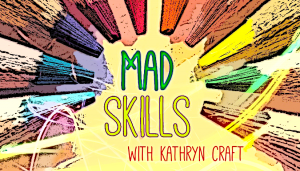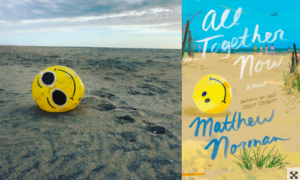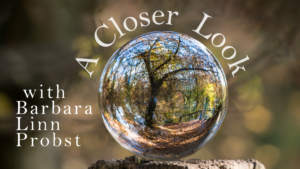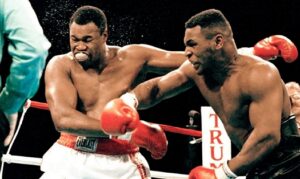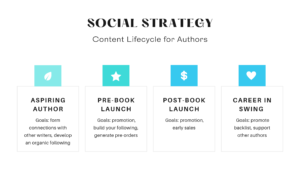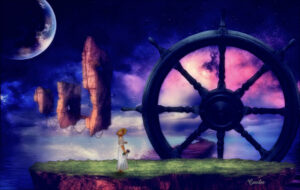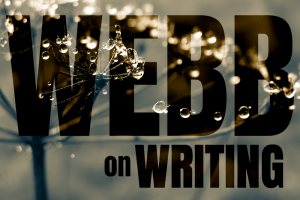Inspirations
photo adapted / Horia Varlan
I suspect we all know people who will walk in a room and say something like, “I still can’t believe she’d quit on me.” I’m married to one of them.
It’s obvious there is conflict, so this might end up being a good story, but right now the comment is floating in space. I’ll need more words to understand it. Who is this woman? Where did he see her? When did this happen—ten minutes ago? Is he still chewing on something from his youth? Or is this a future action that worries him?
One thing is for sure: to assume that I can read his mind is a sweet yet preposterous overestimate of my editorial prowess. I suppose that’s what happens after you’ve been married a few decades.
But judging from the manuscripts I see, it can also be what happens when you are on your umpteenth draft of a novel and can no longer remember which version of which facts are on the page. For that reason, it can be helpful if at some point, before sending your manuscript to beta readers or developmental editors, you take one pass to make sure that you’ve set each scene appropriately.
Although reportage is different than story-building (for more on this you can check my previous post on paragraphing), borrowing the journalist’s 5 W’s can inspire a set of useful questions that will ensure that the scene you’re building is also giving the reader the information she needs.
Who took action, and who did it affect?
What happened, exactly?
Where did it take place?
When did it take place?
Why did it happen, and why does it matter to this particular story and this particular protagonist?
Wait—didn’t you say 3 W’s?
The bare minimum we need at the outset of a scene is the who, when, and where. With that information, “I still can’t believe she’d quit on me” gains context:
It’s been ten years and Simone’s clothes still hang in the back of my closet. I still can’t believe she quit on me.
~or~
I still can’t believe what just happened at the office—Joanna up and walked out on our partnership.
~or~
I backslid at Ed’s retirement lunch; I couldn’t resist the shrimp scampi. I still can’t believe Cleo warned me to stop eating garlic or she’d quit training me at the gym.
I was thinking about this topic after a question was posed on a Facebook page about how to cleverly fold in these details without being as pedestrian as, say, “Meanwhile, back at the ranch, his brother…” The thing is, though, those seven “pedestrian” words perfectly orient us to who, when, and where.
When it comes to setting your scene, clarity—not cleverness—should be your first priority. Let’s look at how that’s done.
Read MoreThe most misunderstood component of fiction craft is also one most commonly discussed: pace. You hear it all the time, especially in critique. “Pace” as a word seems inevitably coupled with words like “slow” and “drags”. It speaks to speed—speed which always, pretty much without exception, could be faster.
But speed of what? Plot pace is generally what people mean. Keep things moving. Get to the next event. Don’t meander around, cut to the chase. Get to the meat and quickly move on. It’s as if story is a double-speed march, or ought to be.
As we know, however, story is not always about moving events along rapidly. A novel is more than that. It includes tone, atmosphere, mood, meaning, motives, world, relationships, reveals, deep dives into character and that’s just for starters. Furthermore, some novels are deliberately “slow”. The pace of events is a crawl and yet we readers remain absorbed. Nuance is explored, moments are put under a microscope, people and places are “closely-observed”, hardly anything seems to happen but every mote of dust feels important.
So how are we to think of pace in a novel like that? For that matter, even mile-a-minute thrillers need to convey a certain amount of information. Circumstances need to be set up. Characters’ thoughts need to be reported. The past must be presented to prepare the present. People have to talk. There are slow-speed traps all over the place and yet when skillfully handled, popular authors never seem to be pulled over by the reader police. Never. How are they doing that?
What makes some patterns of words on the page always work, when other times—particularly when you are following the rules, it seems—you get slammed with the damning word pace! Years ago, I introduced the term micro-tension to describe the line-by-line effect of creating uneasiness in the reader, which can only be relieved by reading the next thing on the page. The term seems to have caught on and I continue to find that micro-tension is the secret behind any novel that we read without ceasing: what we call page-turners.
However, there’s another way to look at it.
The Squirrel in the Road
The other day I was driving my family to the beach. Where we live, that involves a road that inclines sharply downhill. Naturally, drivers tend to speed up. It’s also a moderately wooded area and on that particular day, as I was rolling ever faster down the incline, right in front of us a black squirrel darted into the road.
Immediately, my hands jerked the steering wheel to the right. My right foot flashed to the brake. The squirrel darted to the other side of the road to whatever nutty reward awaited there. I straightened the car and proceeded. Having been trained not to panic, I wasn’t shaken. My heart wasn’t racing. My maneuver was simply an instinctive reaction, an instantaneous electrical impulse shot from eye to brain to muscles.
In the back seat, my son said, “Wow, you have quick reflexes, Dad.” I didn’t say anything because I don’t, not especially, but for a rare second, I was a hero in my kid’s eyes and I’ll take that.
It set me thinking, though, about the speed of thought—and readers. Readers think fast. Readers […]
Read MoreIt’s been hot this week. Really hot. I spent the past several days hauling compost to spread in a vegetable field and pushing wheelbarrows full of hay uphill to cover the compost and keep the moisture in the soil from evaporating.
No shade. Just hot, hot sun. Record-breaking, blistering sun.
With sweat pouring down my neck and back as I spread shovels full of compost, I wondered what this heat would do to my vegetables. They wilted a bit, but they would probably be okay because my well provides abundant water for irrigation. But what if I didn’t have enough water? What if the aquifers dried up? What if the heatwave didn’t break? What if my crops failed? What if everyone’s crops failed?
These questions trouble me as a gardener, but they haunt me as a writer. I can’t stop thinking about various climate futures and what they might look like. What are the worst-case scenarios? And how do we stop them from coming true?
As a writer, I can craft visions of a future version of life on Earth. My novel Waiting for the Night Song imagines a slightly altered version of contemporary New England in which an invasive insect takes up residence in the pine forest. It’s an actual beetle, the same one that has devastated drought-weakened forests in California and Colorado, leaving dead wood that burns like kindling in a wildfire. In my story, a drought in New Hampshire sets the perfect conditions for the opportunistic invader. Will this really happen one day? Maybe. I enjoy exploring the ‘what ifs’ in climate fiction.
In an April 18, 2021 interview in The Guardian, climate fiction author Jeff VanderMeer is quoted as saying, “It’s useful that a novel can be a laboratory of things that haven’t happened and maybe shouldn’t happen.” I turned that nugget of wisdom over and over in my mind. Novels can serve as laboratories for different versions of the future. Maybe when we read about these various futures and envision what life might look like, we will be motivated to stop these visions from becoming our reality.
It’s very likely my beetle will make its way east. This beetle might set the stage for catastrophic fires on the East Coast the way it has out west. Or maybe it won’t. Like Jeff VanderMeer suggested, my book is just a laboratory for one possible future.
Read MoreTwo summers ago, I was having a hell of time getting my forth novel, ALL TOGETHER NOW, off the ground. For me, starting a book always feels like struggling to get a kite in the air. You take a deep breath and start running, hoping and hoping, but then, over and over, the damn thing nose dives and you have to start all over again.
I had the beachy setting all dialed in. I’d outlined the plot from start to finish. I had the characters drawn out nicely in my head. The problem: I couldn’t figure out the tone. I just didn’t know how the book should sound.
In ALL TOGETHER NOW, which came out on June 15, I tackle the most serious subject matter of my writing career. A dying thirty-five-year-old billionaire invites his three best friends to their beloved Fenwick Island in Delaware to say goodbye and to try to repair each of their battered lives. I know, heavy, right? But I didn’t want the book to read like “a big, serious novel.” Sure, I understood that sadness and sentimentality were inevitable, but I wanted it to be funny, too. After all, I’m a comedic novelist, right? <Insert laugh track here>
My initial attempts—freewriting, mostly—were far too depressing. I’d take breaks from reading my own paragraphs to lay my head on the closest flat surface and sigh. My next attempts were worse. Like a study in overcorrection, I found myself writing what sounded like four amateur standup comedians riffing and wisecracking incessantly. I needed to somehow strike a balance—and I was failing miserably.
And then one morning my wife and I took our dogs for a walk on the beach.
We happened to be in Fenwick Island at the time, which was convenient. Fenwick is just a few hours from where we live in Baltimore, so we spend a lot of time there. As our idiot dogs chased after each other, I noticed something odd maybe fifty yards off in the distance. When I went to investigate, I found an abandoned, partially deflated smiley-face beach ball tipped sideways in the sand.
I’m a devout follower of pure randomness. I don’t believe in signs, and I don’t think things are ever “meant to be.” But when I looked down at that poor, pathetic ball, a clearing formed instantly in my mind, because I knew that it represented the exact tone I was going for.
I took a picture with my iPhone and spent the next day staring at it. It was funny, but there was melancholy there, too, along with a hint of darkness in those low-lit clouds. It was a seemingly happy thing that had been knocked on its side. It was beaten and dirty and damaged and it was quickly losing air…but it was doing its best to look on the bright side. I mean, my God, it was perfect.
When the book was mostly finished and my editor and I were working through late edits, I sent her the picture I’d taken, and I gave her an abbreviated version of the above story. Since I’d actually written the busted beach ball into the novel (it appears twice), she thought it’d be a good idea to send the image to the creative […]
Read Morephoto adapted / Horia Varlan
Back in grad school, I would sometimes choreograph for the college dance company in the living room of my apartment. I’d move the furniture and face its big windows, a natural orientation for someone used to dancing in front of a mirror. One day I was lost in the flow of the movement—crouching low, leaping high—when my eyes locked on a man watching me through his window from across the courtyard.
I hit the deck, army-crawled to the window, drew the drapes closed, and hoped to never see him again.
A lesson from the School of Hard Knocks: the dynamic of a scene changes when someone is watching.
Entire fiction projects have been built around the “someone is watching” theme. In literature, think Big Brother in George Orwell’s Communist-inspired 1984 (1949). In film, the protagonist of The Truman Show (1998) thinks he is simply living his life, when in fact he is the unwitting star of a reality show broadcast to a worldwide audience. In TV, Fringe (2008-2013) survived the “Friday night death slot” by pitting an FBI team against happenings ultimately explained by the existence of an alternate universe—while its pale, bald, and definitely creepy Observers took notes on the team’s investigations.
Any story with a stakeout, a stalker, paparazzi, an anonymous protector, or a nosy neighbor (anyone remember Gladys Kravitz on Bewitched?) has a watcher. Someone standing in the wings, literally or figuratively.
In religious stories, God is a watcher. Ghosts are effective watchers. In J.K. Rowling’s Harry Potter series, even the paintings on the wall serve as observers. And I can’t be the only one who has become self-conscious of her behavior while under her pet’s watchful glare.
Watchers raise tension
I happened to be reading Ken Follett’s historical novel Pillars of the Earth (1989) as I formulated this topic and came across a passage of interest. Tom Builder, a mason who was peremptorily dismissed from his last job, must seek new work by walking to the next town with his wife, teenage son, and seven-year-old daughter, Martha. They are carrying their meager possessions on their backs while Martha drives forward their most valuable investment, a pig they’d been fattening all year.
As they walk through the forest, Tom daydreams in detail about the design of the cathedral he hopes to one day build. After a couple of paragraphs comes this passage:
Tom tried to visualize the molding over the windows, but his concentration kept slipping because he had the feeling that he was being watched. It was a foolish notion, he thought, if only because of course he was being observed by the birds, foxes, cats, squirrels, rats, mice, weasels, stoats, and voles which thronged the forest.
Tom talks himself out of his natural fear reflex. After relaxing for a bite to eat by a pleasant stream the family picks up their journey, but Martha gets tired, the pig is obstinate, and both lag behind. Tom looks back and daydreams some more while waiting for them to catch up…
Read MoreKathleen Alcalá’s work often reads like poetry, the sort that draws our attention to the distance between what we think we have seen and what is actually there. Alcalá’s first novel, Spirits of the Ordinary: A Tale of Casas Grandes, originally published in 1996, is being reissued and will be available in May 2021. As a Latina and a writer, I find both solace and inspiration in Alcalá’s work. At every point, she challenges the amnesia that drives the homogenized, often jingoistic narrative about what used to be northern Mexico before President Polk annexed Texas in 1845; and before the treaty of Guadalupe Hidalgo in 1848 conceded California, New Mexico, Arizona, and parts of present-day Utah, Nevada, and Colorado to the US. The Gold Rush begins in 1848, which is a story often untethered from the bloody battles that barely preceded it. There was a gold rush. The West was born. No need to ask about labor pains.
Alcalá, born in California to parents who immigrated from Mexico, belongs to the southwestern US and to northern Mexico. Reach back further in time and she belongs to the indigenous Opata and to Spain. She belongs as well to two religious traditions, Jewish and Christian, for so many of the Spaniards who immigrated to Mexico were Jews fleeing from the brutality of the Inquisition, people who had learned out of necessity to practice their faith in silence, through the rituals of Catholicism and despite them. Alcalá places her characters in this chaotic crush of cultures, languages, and human desire. Yet she brings us back to the ground of those intersections: everything changes except the fact that everything changes. We come to understand the solace to be found in that acknowledgement.
What do we hold in common despite our differences? The full arc of Alcalá’s novel provides the answer, beginning with the epigraph from The Zohar: “In love is found the secret of divine unity. / It is love that unites the higher / and the lower stages of existence, / that raises the lower to the level of the higher — / where all become fused into one.” The novel ends with a double coda of sorts, an epilogue by the character Gabriel, an Evangelical preacher, the eldest son of Zacharías and Estela; and a promise from the prophet Isaiah that despite the darkness that will cover the earth and its people, “the Lord will rise upon you, / and his glory will appear upon you. / And nations will come to your light, / And kings to the brightness of your rising” (60: 1-3). Three of the world’s major religions claim Isaiah–Christianity, Judaism, and Islam. In a novel about how one thing becomes another, how one tradition can be made to hide safely within another, Isaiah reminds us how mysterious life is, and how easily we are duped by the material world and its mirages.
At the center of the novel are Mariana and Julio, Gabriel’s paternal grandparents. As a child, Mariana was bullied by other children. “Hey Christ-killer,” they jeer at her. “See what it feels like to suffer like our Lord Jesus!” They throw rocks that strike Mariana, leaving her unconscious. Then on the ninth day, “she reached out past [her father], […]
Read Morephoto adapted / Horia Varlan
Establishing “agency”—proving to your reader that your protagonist is equal to the journey ahead—is a craft element worthy of fresh consideration each time you begin a new project. This is especially true if you spend a good deal of your initial word count probing the protagonist’s memories and thoughts so you’ll understand the inner conflict that will drive their story.
That’s called “starting to write,” not “opening a novel”—but writers often conflate the two.
Reality is, you-as-author are the one who needs early access to that interiority. Your reader might not. Any reader who has met with an unreliable narrator will know that a character’s actions will speak louder than anything s/he is willing to tell us anyway. In order to earn your reader’s faith and investment, your protagonist must be willing to act.
This craft is based on physical law. As early as 1687, storytelling guru Sir Isaac Newton hinted at the necessity of getting your protagonist off his duff with his principle of inertia, which (sort of) states:
A protagonist at rest will stay at rest, and a protagonist in motion will stay in motion until his story problem is resolved, unless acted on by an external force.
Before submitting your manuscript to publishers, consider having your story open with your character already taking an action that suggests the nature of the journey ahead. Once that happens, Newton’s Third Law of Storytelling (oh why not rename them?) promises that “for every action there is an equal and opposite reaction.”
Action—not thought—inspires the kind of external conflict that will pressure your character to engage with an inner arc of change.
Action—not thought—will show the character’s agency.
Merriam-Webster’s first definition of the word “actor” offers a simple perspective on the matter.
One that acts: doer.
Even a dazed woman wandering through a forest is different from one sitting on a stump thinking about how lost she is: the wanderer is looking for a way out.
This raises the question of whether all characters are capable of “doing” something. Let’s look at three increasingly challenged protagonists.
Anne Shirley
Even kids—and characters seized by PTSD—can act (or act out). If you don’t remember the 1908 novel Anne of Green Gables by Lucy Maud Montgomery, watch a couple of episodes of Anne with an “E” on Netflix. At the outset, Anne, “about eleven” in the novel, is waiting alone at a train stop for her new foster father to pick her up—and when he approaches, she starts talking so fast and at such length that he can’t possibly pose the objection that he had specifically asked for, and expected to meet, a boy.
Read More
Please welcome back today’s guest: author Alison Hammer! During the day, Alison is a VP Creative Director for an advertising agency in Chicago, and nights and weekends, she writes upmarket women’s fiction—stories about family and friendship, love and loss. She also founded the Every Damn Day Writers group on Facebook.
Her two novels, You and Me and Us (April 2020) and Little Pieces of Me (April 13th, 2021), are unique in that they will both be released during the pandemic–when book releases as we knew them could not exist. But they still did exist in the digital landscape–a landscape that not only had to be navigated but also, in some instances, created. These new digital landscapes won’t just evaporate when the pandemic lifts, either. Rather, many of them will be sustained and used to complement traditional book release efforts.
So what are those strategies? Who better to tell us than Alison herself! Oh, and her favorite cake is vanilla with white frosting—classic and simple but so good. What does cake have to do with anything? Well, read on.
We’d also be remiss not to share Alison’s launch party information with you today! Check it out on her website, HERE, and follow her on Instagram, Facebook, Twitter, Bookbub, and Goodreads.
A 2nd Pandemic Book Release: Piece of Cake and Other Silver Linings
What a long, strange year it’s been! The last time I wrote for Writer Unboxed, I was just a few weeks away from launching my debut novel—a time in a writer’s life that can be filled with stress and crippling anxiety even when there isn’t a global pandemic going on.
A year later, I’m getting ready to launch a second book during the pandemic—but this time it’s not quite as scary or nerve-wrecking. While of course I’m disappointed to be missing out on some author-moments I still haven’t experienced, I know enough to look for the silver linings. And there are a lot of them.
Starting with my launch party.
Now, don’t get me wrong—I have had dreams about the in-person launch event that never happened. There was going to be a big poster-sized version of my book cover, a giant cake featuring my cover from Sweet Mandy B’s, my favorite Chicago bakery, and I was going to sign books until my hand hurt while someone from the bookstore went through the line, writing people’s names on a Post-It note, saving me from a potentially embarrassing moment if I forgot the name of someone I was supposed to know. (I always thought that was so smart!)
While that dream is still a dream, I had to let go of what was supposed to be and accept what was. Which leads me to point number one.
THE FIRST RULE OF THROWING A VIRTUAL EVENT
As much as you might think it’s a good idea to plan an event that re-creates an in-person experience, I have to tell you, it’s not. The two types of events have such different pros and cons, you’ll be much better off if you fully embrace the virtual space.
This honestly happened by accident the first […]
Read MoreDays before my paperback launch, my publisher called me in a panic. “Where are your blurbs? You were supposed to submit all new blurbs for the paperback release!”
“No one told me,” I sputtered. Apparently, I wasn’t allowed to reuse the blurbs from my hardcover edition, but I didn’t know. I didn’t know! My pulse quickened and I tried to catch my breath.
“Well, it’s too late now.” Her voice dripped with rage and, even worse, disappointment in me. “It’s going to press with nothing on the cover.”
I tried to speak, but the words would not form. Sweat poured down my face and back. My paperback would surely flop. Who would buy a book with nothing on the cover? My writing career was doomed.
Then I woke up, shaken and sweaty, but oh, so relieved.
It was just a dream.
A wave of relief washed over me as I remembered my paperback doesn’t launch for nine months. I buried my head in my pillow and tried, without success, to go back to sleep.
My writer brain has been in high gear these last few months as I launched my debut novel Waiting for the Night Song. Bookstore events, interviews, Q&As. I’m also working on deadline for my second book. These are good problems to have, but I constantly feel like I’m about to forget something big. That fear manifested into my blurbless paperback dream, which may sound silly, but it really rattled me.
The morning after, I shared my dream with writer friend Sarah Penner (The Lost Apothecary,) who then told me about her dream from the night before. She dreamed that our mutual friend Nancy Johnson (The Kindest Lie) had sent her a new manuscript to beta read. Sarah panicked because she didn’t have time to read Nancy’s book, but Sarah didn’t want to let Nancy down. Sarah, who is working on her own new manuscript, enviously wondered how Nancy could have possibly finished writing a book that she just started working on.
I don’t have any credentials in dream interpretation, but I’m guessing Sarah, like me, was feeling crunched for time, worried about forgetting something, and guilty for not being able to get to everything in a timely manner. And, of course, we always have our eyes on someone else’s paper.
I checked in with some other writer friends and have developed a theory that our brains keep writing (or at least think about writing) when we go to sleep. The resulting dreams usually fall into one of three categories: The Stress Dream, The Flash-of-Brilliance Dream, or the Living-in-Your-Book Dream.
The Stress Dream
Based on my very unscientific poll of some writer friends, the Stress Dream seems to be the most common, which doesn’t surprise me. Writers tend to be high-strung, deep thinkers. We internalize fears and anxieties and stew on them, even while we sleep.
Read MoreI’m working on my eighth novel and it’s a confounding one. I’ve never written a dual biographical historical before, especially with two fairly modern “characters” (and with that, an absolute ENORMOUS amount of research). What’s more, this dang manuscript is giving me fits—it won’t let me write it my way or use the tried-and-true process I’ve relied upon in the past for biographicals. The process has completely toppled over and spun around and here I am, working BACKWARD from the END of the book. Though it’s moving slowly, I was completely stuck trying go in my typical linear fashion from beginning to end. I am also being forced to write several chapters in one point of view, and then the other, and afterward, weave them together in a way that makes sense before I start work on another set of chapters. scratches head I just don’t know, you guys.
If there’s one thing that has mostly remained a mystery to me as an author—even after writing eight novels and three short stories—it’s the writing process. The writing process is an amorphous, wiggly, glob with a million arms and as soon as I feel like I’ve caught hold of one, it slips out of my hands. To make it more challenging, we have all of these writerly emotions surrounding our manuscripts so when things aren’t going “well,” we feel like we’re constantly doing it all wrong, that there MUST be a better way to do things.
For example…
Read More
